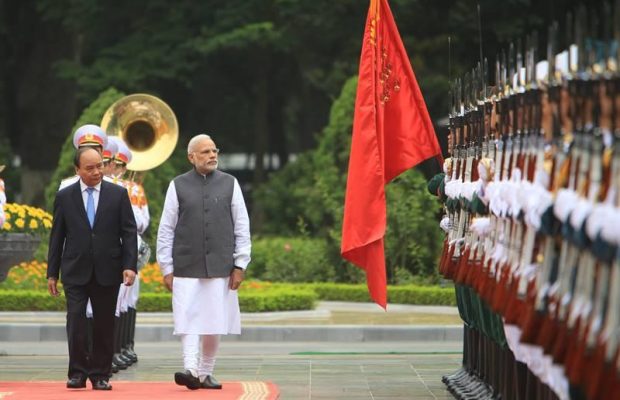Exercise caution, not exuberance

It is yet to be seen whether India will gain anything substantial from Prime Minister Narendra Modi’s meeting with Vietnamese President Tran Dai Quang and Prime Minister Nguyen Xuan Phuc. But the chaos it has sparked just ahead of theG20 summit in China is significant. India’s stance on the South China Sea has long been that China should abide by the United Nations Convention on the Law of the Sea (UNCLOS). New Delhi has always maintained that there should be freedom of navigation on international waters.
India’s decision to provide Vietnam with four patrol boats for surveillance in the South China Sea and the proposed sale of BrahMos missiles are enough to catch China’s attention. Historically, the South China Sea has been a cause for dispute between China and eight other countries, including Vietnam, Malaysia, Philippines, and Brunei. However, the situation has reached alarming levels recent times. The Philippines government has hailed India’s support for its case against China on the South China Sea and called for deepening of ties. Under these conditions, Modi has sought a bilateral meeting with its new President Rodrigo Duterte on the sidelines of the upcoming East Asia Summit (EAS) in Laos on September 6.
In a strong show of support to the Philippines, India made it clear that all countries should exercise self-restraint. “As a State Party to the UNCLOS, India urges all parties to show utmost respect for the UNCLOS, which establishes the international legal order of the seas and oceans,” Minister of State for External Affairs VK Singh said, referring to the UN tribunal’s July 12 rejection of Beijing’s claim over the strategic waters. China has found India’s stand on the South China Sea dispute as an “unnecessary entanglement”. India’s decision to interfere in the matter could have “unnecessary side effects”, Beijing argued. China’s decision to stall India’s entry into the Nuclear Suppliers Group has urged New Delhi to become more proactive in the South China Sea, which could emerge as a theatre of war in the 21st century. The implicit message is that China must address India’s legitimate concerns. Beijing has purposefully followed a policy of not allowing other regional littoral countries to move their ships freely in the South China Sea. In turn, clashes between China and other countries have significantly increased. Most countries in the region share cordial relations with India.
The South China Sea is home to huge oil and gas reserves and also serves as the a critical shipping route between Pacific and Indian Oceans. China desires to establish itself as the indisputable power in this region. This is precisely the reason Beijing also frequently questions the presence of external powers like the US, stating that the South China Sea is its “core interest”. Mindful of Beijing’s position, the US has made calibrated efforts to protect this region from Chinese domination. India has a vital role to play. Washington is seeking help from Asian military powers like Japan and India to maintain peace and security in the South China Sea.
Approximately 50 percent of India’s trade travel eastwards to the Asia-Pacific countries via the South China Sea. Therefore it is very important for India to ensure that there is absolute freedom of navigation. India’s relationship with ASEAN has improved significantly since the 1990s. Prime Minister Narendra Modi’s “Act East” policy is in tune with the Congress governments of the past. India has become one of the few external forces involved in oil and gas exploration in the region. Thus, New Delhi has to ensure the prevalence of peace and security in this region so as to meet its energy requirements. In 2011, China aggressively opposed the activities of our state-owned oil company ONGC Videsh Limited (OVL) in the South China Sea. But Dr Manmohan Singh, the then Prime Minister, refused to bow before the Chinese. A year later, in the ASEAN Regional Forum Summit in Phnom Penh in 2012, India emphasised its strong support for freedom of navigation and access to resources such as fisheries and gas in accordance with principles of international law.
The South China Sea has been a secondary zone of interest for Indian Navy for a long time. But it needs a cautious plan to increase its presence in the region. Experts feel that by meddling in maritime theatres that do not directly concern India, it will be distracted from activities that lay squarely within what ought to remain India’s principal area of focus, namely the Indian Ocean in general and the Arabian Sea and Bay of Bengal in particular. Some 25 percent of all India’s external maritime trade—approximately 190 billion dollars worth—pass through the South China Sea, bound to and from Vietnam, Cambodia, Lao, North and South Korea, China, Hong Kong, Japan, Pacific Russia, and the western seaboard of the USA. It is certainly susceptible to geopolitical disruptions.
Narendra Modi, therefore, has a difficult job to handle while deciding the exact level of India’s involvement in the South China Sea. One can only hope that he has the required team of mature advisors who can deal with China on such a sensitive subject. Mere showmanship will not address serious questions. Riding on the waves of South China Sea has not sowed fear in Beijing. One has to be an experienced and competent diplomat to even enter the arena of this game. This is no time for any over enthused experiment as it can cost India in a big way. Let us with exercise caution and indulge in adventures and not with exuberance.









You must be logged in to post a comment Login